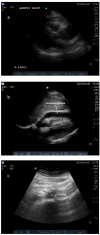Point of care cardiac ultrasound applications in the emergency department and intensive care unit--a review
- PMID: 22894759
- PMCID: PMC3406278
- DOI: 10.2174/157340312801784952
Point of care cardiac ultrasound applications in the emergency department and intensive care unit--a review
Abstract
The use of point of care echocardiography by non-cardiologist in acute care settings such as the emergency department (ED) or the intensive care unit (ICU) is very common. Unlike diagnostic echocardiography, the scope of such point of care exams is often restricted to address the clinical questions raised by the patient's differential diagnosis or chief complaint in order to inform immediate management decisions. In this article, an overview of the most common applications of this focused echocardiography in the ED and ICU is provided. This includes but is not limited to the evaluation of patients experiencing hypotension, cardiac arrest, cardiac trauma, chest pain and patients after cardiac surgery.
Figures




Similar articles
-
Focused cardiac ultrasound (FOCUS) by emergency medicine residents in patients with suspected cardiovascular diseases.J Ultrasound. 2017 May 2;20(2):133-138. doi: 10.1007/s40477-017-0246-5. eCollection 2017 Jun. J Ultrasound. 2017. PMID: 28593003 Free PMC article.
-
Contemporary Application of Point-of-Care Echocardiography in the Emergency Department.Can J Cardiol. 2018 Feb;34(2):109-116. doi: 10.1016/j.cjca.2017.08.018. Epub 2017 Sep 1. Can J Cardiol. 2018. PMID: 29273259 Review.
-
Impending cardiac tamponade: a case report highlighting the value of bedside echocardiography.J Emerg Med. 2006 May;30(4):415-9. doi: 10.1016/j.jemermed.2005.07.012. J Emerg Med. 2006. PMID: 16740452
-
Point-of-care echocardiography by pediatric emergency physicians.Pediatr Emerg Care. 2011 Aug;27(8):693-6. doi: 10.1097/PEC.0b013e318226c7c7. Pediatr Emerg Care. 2011. PMID: 21811201
-
Cardiac echocardiography.Crit Care Clin. 2014 Jan;30(1):47-92, v. doi: 10.1016/j.ccc.2013.08.003. Crit Care Clin. 2014. PMID: 24295841 Review.
Cited by
-
Rapid development of image analysis research tools: Bridging the gap between researcher and clinician with pyOsiriX.Comput Biol Med. 2016 Feb 1;69:203-12. doi: 10.1016/j.compbiomed.2015.12.002. Epub 2015 Dec 18. Comput Biol Med. 2016. PMID: 26773941 Free PMC article.
-
Point-of-care echocardiography - A road to future or a step backwards.Australas J Ultrasound Med. 2019 Feb 19;22(1):26-31. doi: 10.1002/ajum.12128. eCollection 2019 Feb. Australas J Ultrasound Med. 2019. PMID: 34760533 Free PMC article. Review.
-
Critical asthma syndrome in the ICU.Clin Rev Allergy Immunol. 2015 Feb;48(1):31-44. Clin Rev Allergy Immunol. 2015. PMID: 25759905 Review.
-
Echocardiography in the diagnosis of Shone's complex and analysis of the causes for missed diagnosis and misdiagnosis.World J Clin Cases. 2022 Apr 16;10(11):3369-3378. doi: 10.12998/wjcc.v10.i11.3369. World J Clin Cases. 2022. PMID: 35611202 Free PMC article.
-
Prognostic Utility of Pericardial Effusion in the General Population: Findings From the STAAB Cohort Study.J Am Heart Assoc. 2024 Jun 18;13(12):e035549. doi: 10.1161/JAHA.124.035549. Epub 2024 Jun 15. J Am Heart Assoc. 2024. PMID: 38879452 Free PMC article.
References
-
- Plummer D, Brunette D, Asinger R, Ruiz E. Emergency department echocardiography improves outcome in penetrating cardiac injury. Ann Emerg Med. 1992;21(6):709–12. - PubMed
-
- Labovitz A, Noble V Bierig M, et al. Focused cardiac ultrasound in the emergent setting: a consensus statement of the American Society of Echocardiography and American College of Emergency Physicians. J Am Soc Echocardiogr. 2010;23(12):1225–30. - PubMed
-
- Mayo P, Beaulieu Y, Doelken P, et al. American College of Chest Physicians/La Société de Réanimation de Langue Française statement on competence in critical care ultrasonography. Chest. 2009;135(4):1050–60. - PubMed
-
- Stewart W, Douglas P, Sagar K, et al. Echocardiography in emergency medicine: a policy statement by the American Society of Echocardiography and the American College of Cardiology. The Task Force on Echocardiography in Emergency Medicine of the American Society of Echocardiography and the Echocardiography TPEC Committees of the American College of Cardiology. J Am Soc Echocardiogr. 1999;12(1):82–4. - PubMed
-
- Moore C, Copel J. Point-of-care ultrasonography. N Engl J Med. 2011;364(8):749–57. - PubMed
Publication types
MeSH terms
LinkOut - more resources
Full Text Sources
Medical

